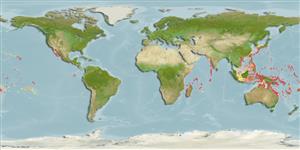>
Ophidiiformes (Cusk eels) >
Carapidae (Pearlfishes) > Carapinae
Etymology: Onuxodon: Greek, onyx, -ychos = nail + Greek, odous = teeth (Ref. 45335).
More on author: Fowler.
Environment: milieu / climate zone / depth range / distribution range
بوم شناسي
دريايي نزديك كف زي; تغييرات عمق 1 - 30 m (Ref. 58302). Subtropical
Indo-Pacific: South Africa to Hawaii.
Size / Weight / سن
Maturity: Lm ? range ? - ? cm
Max length : 10.0 cm TL جنس نر / بدون خواص جنسي; (Ref. 4104)
شعاع نرم باله پشتي (کل) : 44 - 47; شعاع نرم باله مخرجي: 44 - 51. Eel-like, shallow to moderate body depth; adults small, less than 100 mm, trunk compressed; 1 to several large symphyseal fangs on premaxilla and dentary; anterior swim bladder modified into 'rockerbone'; predorsal bone present; pectoral fin rays supported by numerous small distal radials (Ref. 34024). Pectoral fins short; eyes small; lateralis papillae not visible on head or anterior lateral line (Ref. 34024).
A benthic species (Ref. 58302, 75154) found in coral reefs (Ref. 75154). Uncommon species (Ref. 34024). Commensal inquiline in the giant oyster Pycnodonta hyotis (Ref. 4104).
Life cycle and mating behavior
Maturities | تولید مثل | Spawnings | Egg(s) | Fecundities | توزاد ( لارو)
Nielsen, J.G., D.M. Cohen, D.F. Markle and C.R. Robins, 1999. Ophidiiform fishes of the world (Order Ophidiiformes). An annotated and illustrated catalogue of pearlfishes, cusk-eels, brotulas and other ophidiiform fishes known to date. FAO Fish. Synop. 125(18):178p. Rome: FAO. (Ref. 34024)
وضعيت در فهرست قرمز IUCN (Ref. 130435)
خطر برای انسان ها
Harmless
استفاده انسانی
ماهي گيري – شيلات: از بی علاقه گی
ابزارها
گزارش های ويژه
بارگيری XML
منابع اينترنتي
Estimates based on models
Preferred temperature (Ref.
123201): 23.1 - 29.2, mean 28 °C (based on 2331 cells).
Phylogenetic diversity index (Ref.
82804): PD
50 = 0.6250 [Uniqueness, from 0.5 = low to 2.0 = high].
Bayesian length-weight: a=0.00102 (0.00046 - 0.00225), b=3.06 (2.88 - 3.24), in cm total length, based on all LWR estimates for this body shape (Ref.
93245).
Trophic level (Ref.
69278): 3.3 ±0.4 se; based on size and trophs of closest relatives
Fishing Vulnerability (Ref.
59153): Low vulnerability (10 of 100).
